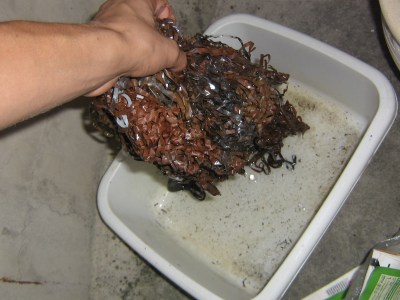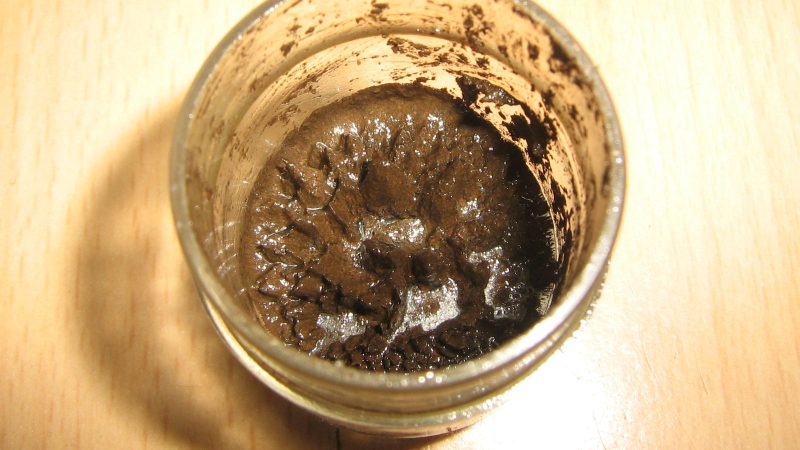Ferrofluid is a wonderous substance. It’s a liquid goop that responds to magnetic fields in exciting and interesting ways. It’s actually possible to make it yourself, and it’s cheap, too! The key is to get yourself some old VHS tapes.

The trick is to separate the ferric oxide from the plastic tape inside the VHS cassette. Step one is naturally to smash open a cassette, and pull out the plastic tape from inside. The tape can then be dunked in acetone to dissolve the plastic, leaving behind the ferric oxide that once stored your cherished copy of Heat. A magnet is an easy way to collect the ferric oxide, which should then be left to dry. The powdery substance can then be blended in a ratio of 1 mL of ferric oxide to 0.333 mL of cooking oil. Poor mixing can be improved by adding a droplet of water mixed with dish detergent. You should end up with a brownish sludge that acts as a rudimentary ferrofluid.
It’s a neat bit of home science. As with most such activities, it bears noting the safety risks. Don’t leave your acetone uncovered to form a nasty flammable vapor, and keep yourself keenly aware of any fire or ignition risks. Overall though, it’s a fairly straightforward process. While the resulting material isn’t necessarily lab grade, you could potentially use it to build your own ferrofluid display!

















Use mineral oil instead of cooking oil and it will not go rancid, staining and smelling less over time.
Yeah and do yourself a favor and don’t cook with it either, that stuff is basically subpar furniture polish. This is a pretty neat trick though.
Don’t cook with ferrofluid or with vegetable oil?!
I think he meant not to cook with mineral oil (which is a basic component of furniture polish)
better use old laser printer cartridge
What part of the cartridge? What’s magnetic? Laser toner is plastic, right?
Ah.. looking around the interwebs, I found some recipes that use MICR toner/ink used for printint the mag-read numbers on checks. Maybe that’s what you mean?
in laser printer ferric oxide is used to move particles of the toner to printouts
Just dismantle your old laser printer cartridge
just read
Iron oxide in current laser toner cartridges
https://h30434.www3.hp.com/t5/Printers-Archive-Read-Only/iron-oxide-in-current-laser-toner-cartridges/td-p/1711531
listing cartridges by code numbers
Cool, but for $2 one can get 100g of pretty pure ferric oxide.
Art supply store. It’s a pigment. They’ll even have ground it to a fine powder for you already.
Yep, and for example PBk11 is deep black, not this shit looking mess. Go shopping with a magnet to be sure you are getting the right stuff, try to move it up the walls of the container. handprint.com is a nice resource of watercolors, which are pretty much the same than those sold as raw pigments at art supply stores. PBk11 appears as “Magnetic black or iron oxide black” *wink*wink* in that site under the “black” category. The one used in tapes could be from “earth” pigments, like PBr6 or PR101.
The Acetone will dissolve the plastic substraite, but if you let the Acetone evaporate, the plastic may precipitate back out. You have to disolve the substrate, then separate the iron oxide, and wash the iron oxide again with more acetone. Then you will get a pure sample of Iron Oxide. Also silicon oil is sometimes used for a better result.
Also, please note what material the container is made of. Glass and metal are resistant to acetone’s unique charms, but a random plastic bucket might dissolve as quickly as the tape, releasing the remaining acetone, which will then set about what other deviltry it can find. Plastic drain pipes have been known to succumb to the attentions of acetone. Maybe don’t leave this alone in your kitchen.
High-density polyethylene (HDPE, recycling #2) and polypropylene (PP, recycling #4) are the best plastics for acetone resistance. (Well, PTFE would be even better but kinda hard to find consumer-type containers made of Teflon…) Glass or metal is fine, of course. Metal coffee cans or giant economy-sized cans of green beans.
Most large plastic jugs that contain laundry detergent are thick HDPE and are ideal for this. And the cost is just right.
Chem lab rule of thumb for washing precipitates: three washes, allowing the solvent to contact all the precipitate and to drain thoroughly each time. And three washes of 25 mL each are MUCH, MUCH more effective than one wash with 75 mL, or even one wash with 200 mL.
Silicone oil is a surfactant. A few drops added to the acetone may make the washing procedure more effective, I don’t know. I use it to help “pop” bubbles in a slurry that I make on occasion.
cool… but what am I gonna do with it.
Sure, ferrofluid is fun to play with, but is there a serious application for the common hacker other than an energy hungry (but very very cool looking) clock?
Since it’s a fluid things can get very messy if a project starts to leak. An elektromagnetic clutch would be nice or a device to view magnetic fields. Hmmm… things to think about during hollidays, I feel 2023 is going to be a fun year with this new ferrofluid recipe.
My take is that ferrofluid is just for fun. And then, only occasionally. Think of it like a frisbee rather than a soldering iron, and you’re in the right mindset. It’s not always a sunny day in the park.
I have had a small bottle on the shelf for > 10 years, and have probably played with it about five times. But it’s a high-level wizard event when you’re able to say “hold on, I have something for this” when your son is playing around with a coil of wire and a 9V.
When the fluid form ceases to amuse, there’s always the magnetic silly putty experiment. The technique to make “kinetic sand”, if it coats Fe3O4 as well as SiO2, should yield interesting results.
I looked into using it when I needed a _very_ rapidly adjustable damper to control the release of spring tension to squish a materials sample at high strain rates. (crash test dummy materials)
In the end I used a 100kg 3000rpm flywheel, a clutch and a cam, though…
I think the damper + huge springs design might have explosively disassembled less often.
Magnetorheological (MR) dampers don’t use ferro fluid. Ferro fluid has nano sized particles that will flow with the electric field (hence the cool display) micro size particles will clump together under magnetic field increasing the apparent viscosity. Its pretty cool the MR fluid will go from a light oil to feeing like a lump of clay.
Thanks. I think that I probably knew that then (it was last century).
So I withdraw my candidate for a practical use for this ferrofluid.
I have a set of speakers with (allegedly) ferrofluid enhanced midranges. Seems like a reasonable way to fill an air gap for things that have to move and could take a bit of viscous damping.
Ferrofluid is common on tweeters but I’ve not heard of it being used on midbass drivers before. It’s the reason for certain vintage tweeters on high end speakers being quite valuable: the ferrofluid goes sticky and kills the tweeter and modern replacements don’t quite match the sound. You can replace it but you have to get to it before the coil goes.
Ferrofluid is sometimes used to cool electric motors. I’ve used it with great success to cool large brushless hub motors such as those used for electric bikes, e scooters, etc. These motors are typically sealed, the laminated stator with its copper windings has an axle in the middle, the stator is surrounded by the rotor which is a ring of steel which has neo magnets glued. The air gap between the magnets and stator is very small. Since it’s sealed the stator with its copper coils heats up quickly, no airflow to help with cooling. The Ferrofluid is applied to the air gap between stator and neo magnets/rotor where it acts as a thermal bridge carrying heat to the rotor which is in contact with the air to help it radiate away faster. Ferrofluid stays put in the air gap because well, it’s magnetically attracted to the permanent magnets. This is actually sold as a product called statorade.
Does that increase or reduce the effective airgap? I could imagine that it helps “conduct” the field as well as the heat>
I remember seeing this method discussed over a decade ago – nowadays it’s almost easier to find ferrofluid than VHS tapes!
And that 2 days after someone put 3 boxes of VHS tapes on the sidewalk! Anyway, can’t do this as I’m highly allergic to acetone.
There is NO such thing as an alergy to acetone. Acetone as in dymethylketone is a part of normal metabolic processes (and abnormal one too).
Nail polish remover and other bs beuaty products and even various acetone based solvents are a long cry from pure acetone and there may be things you are alergic to but not the acetone itself it is imposible.
Get elbow length neoprene chemical gloves (unless you’re allergic to neoprene) and a PAPR with a filter rated for organic vapors.
aka the forbidden Nutella
The collector in me we backs away in horror at the prospect of destroying VHS tapes to make a bad version of something that already exists in a better form factor
Or…make it from scratch
https://youtu.be/6L8yUY-doNc
Why not just use rust instead? Recording tapes are essentially just rust on plastic. People collect VHS tapes, and some YouTubers and influencers use video cassette tapes to create a “retro” effect.
Had either of you tried to dissolve VHS tape in acetone? It doesn’t work as the plastic film is some kind of PET. I had take cooking for 8 hours in acetone now, it does nothing. The picture above shows audio tape which may have a different take plastic. I also tried methanol an diethyl ether..